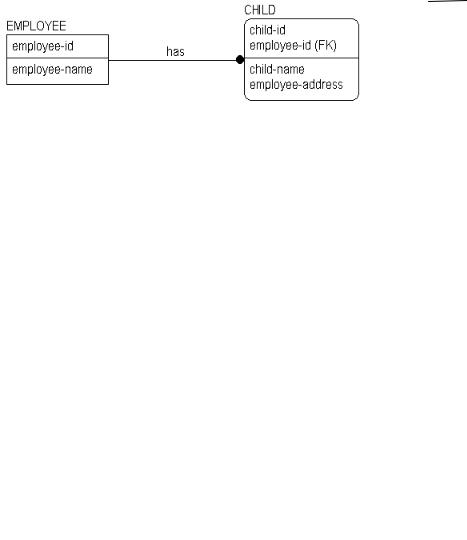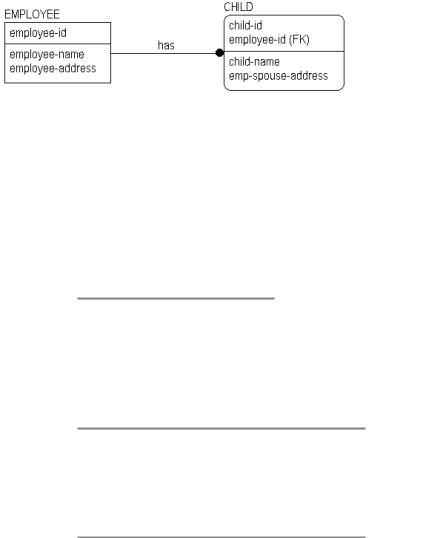
- •Contents
- •Preface
- •Intended Audience
- •About this Guide
- •Typographical Conventions
- •Related Documentation
- •What’s In This Chapter?
- •Chapter Contents
- •What is Data Modeling?
- •Data Modeling Sessions
- •Session Roles
- •Sample IDEF1X Modeling Methodology
- •Logical Models
- •The Entity Relationship Diagram
- •The Key-Based Model
- •The Fully-Attributed (FA) Model
- •Physical Models
- •The Transformation Model
- •The DBMS Model
- •Benefits of Modeling in ERwin
- •What’s In This Chapter?
- •Chapter Contents
- •The Entity-Relationship Diagram
- •Defining Entities and Attributes
- •Logical Relationships
- •Many-to-Many Relationships
- •Validating the Design of the Logical Model
- •Data Model Example
- •What’s In This Chapter?
- •Chapter Contents
- •Understanding Keys
- •Selecting a Primary Key
- •Designating Alternate Key Attributes
- •Inversion Entry Attributes
- •Relationships and Foreign Key Attributes
- •Dependent and Independent Entities
- •Identifying Relationships
- •Non-Identifying Relationships
- •Rolenames
- •What’s In This Chapter?
- •Chapter Contents
- •Naming Entities and Attributes
- •Synonyms, Homonyms and Aliases
- •Entity Definitions
- •Descriptions
- •Business Examples
- •Comments
- •Definition References and Circularity
- •Constructing a Business Glossary
- •Attribute Definitions
- •Rolenames
- •Definitions and Business Rules
- •What’s In This Chapter?
- •Chapter Contents
- •Relationship Cardinality
- •Cardinality in Non-Identifying Relationships
- •Referential Integrity
- •Reading Referential Integrity Options
- •RI, Cardinality, and Identifying Relationships
- •RI, Cardinality, and Non-Identifying Relationships
- •Additional Relationship Types
- •Many-to-Many Relationships
- •N-ary Relationships
- •Recursive Relationships
- •Subtype Relationships
- •Complete Versus Incomplete Subtype Structures
- •Inclusive and Exclusive Relationships
- •IDEF1X and IE Subtype Notation
- •When to Create a Subtype Relationship
- •Introduction
- •Chapter Contents
- •Overview of the Normal Forms
- •Functional Dependence (FD)
- •Full Functional Dependence
- •First Normal Form (1NF)
- •Second Normal Form (2NF)
- •Third Normal Form (3NF)
- •Common Design Problems
- •Repeating Data Groups
- •Multiple Use of the Same Attribute
- •Multiple Occurrences of the Same Fact
- •Conflicting Facts
- •Derived Attributes
- •Missing Information
- •Unification
- •How Much Normalization Is Enough?
- •Conclusions
- •ERwin Support for Normalization
- •First Normal Form Support
- •Second and Third Normal Form Support
- •What’s In This Chapter?
- •Chapter Contents
- •Creating a Physical Model
- •Denormalization
- •Classification of Dependent Entities
- •Glossary of Terms
- •Index
- •Documentation Comments Form

ERwin Methods Guide |
6 |
|
|
Each of the two previous situations contained a first normal form error. By changing the structures we have made sure that an attribute appears only once in the entity, and that it carries only a single fact. If you make sure that all entity and attribute names are singular, and that no attribute can carry multiple facts, then you will have taken a large step toward assuring that a model is in first normal form.
Multiple Occurrences of the Same Fact
One of the goals of a relational database is to maximize data integrity, to ensure that the information contained in the database is correct and that facts within the database do not conflict. To maximize data integrity, it is important to represent each fact in the database once and only once. If a fact appears in two or more places, errors can begin creep into the data. The only exception to this rule (one fact in one place) is in the case of key attributes, which appear multiple times in a database. The integrity of keys, however, is managed using referential integrity, which is discussed earlier in this book.
Multiple occurrences of the same fact often point to a flaw in the original database design. In the example below, you can see that including “employeeaddress” in the CHILD entity has introduced an error in the database design. If an employee has multiple children, the address must be maintained separately for each child.
Multiple Occurrences of the Same Fact
“Employee-address” is information about the EMPLOYEE, not information about the CHILD. In fact, this model violates second normal form, which states that each fact must depend on the entire key of the entity in order to belong to the entity. The example above is not in second normal form because “employee-address” does not depend on the entire key of CHILD, only on the “employee-id” portion, creating a partial key dependency. If you place “employee-address” back with EMPLOYEE, you can ensure that the model is in at least second normal form.
Normalization ∙ 77

6 |
ERwin Methods Guide |
|
|
Conflicting Facts
Conflicting facts can occur for a variety of reasons, including violation of first, second or third normal forms. An example of conflicting facts occurring through a violation of second normal form appears below:
EMPLOYEE-CHILD Model With Conflicting Facts
EMPLOYEE
emp-id emp-name |
emp-address |
|
E1 |
Tom |
Berkeley |
E2 |
Don |
Berkeley |
E3 |
Bob |
Princeton |
E4 |
Carol |
Berkeley |
|
|
|
CHILD
emp-id child-id |
child-name |
emp-spouse-address |
|
E1 |
C1 |
Jane |
Berkeley |
E2 |
C1 |
Tom |
Berkeley |
E2 |
C2 |
Dick |
Berkeley |
E2 |
C3 |
Donna |
Cleveland |
E4 |
C1 |
Lisa |
New York |
Sample Instance Tables Showing “Emp-spouse-address”
The attribute named “emp-spouse-address” is included in CHILD, but this design is a second normal form error. The instance data highlights the error. As you can see, Don is the parent of Tom, Dick, and Donna but the instance data shows two different addresses recorded for Don’s spouse. Perhaps Don has two spouses (one in Berkeley, and one in Cleveland), or Donna has a different mother from Tom and Dick. Or perhaps Don has one spouse with addresses in both Berkeley and Cleveland. Which of these is the answer? There is no way to know from the model as it stands. Business users are the only source that can eliminate this type of semantic problem, so analysts need to ask the right questions about the business to uncover the correct design.
78 ∙ Normalization

ERwin Methods Guide |
6 |
|
|
The problem in the example is that “emp-spouse-address” is a fact about the EMPLOYEE’s SPOUSE, not about the CHILD. If we leave the structure the way it currently is, then every time Don’s spouse changes address (along with Don, we presume), we will have to update that fact in multiple places; once in each CHILD instance where Don is the parent. And if we have to do that in multiple places, what is the chance that we will always get it right everywhere? Not too good.
Once it is recognized that “emp-spouse-address” is a fact not about a child but about a spouse, you can correct the problem. To capture this information, you can add a SPOUSE entity to the model.
Spouse Entity Added to the EMPLOYEE-CHILD Model
EMPLOYEE
emp-id emp-name |
emp-address |
|
E1 |
Tom |
Berkeley |
E2 |
Don |
Berkeley |
E3 |
Bob |
Princeton |
E4 |
Carol |
Berkeley |
Sample Instance Tables
Normalization ∙ 79

6 |
ERwin Methods Guide |
|
|
|
||
|
|
CHILD |
|
|
|
|
|
|
|
|
|
|
|
|
|
emp-id child-id |
child-name |
|
|
|
|
|
E1 |
C1 |
Jane |
|
|
|
|
E2 |
C1 |
Tom |
|
|
|
|
E2 |
C2 |
Dick |
|
|
|
|
E2 |
C3 |
Donna |
|
|
|
|
E4 |
C1 |
Lisa |
|
|
|
|
|
|
|
|
|
|
|
SPOUSE |
|
|
|
|
|
|
|
|
|||
|
|
emp-id spouse-id |
spouse-address current-spouse |
|||
|
|
E2 |
S1 |
Berkeley |
Y |
|
|
|
E2 |
S2 |
Cleveland |
N |
|
|
|
E3 |
S1 |
Princeton |
Y |
|
|
|
E4 |
S1 |
New York |
Y |
|
|
|
E5 |
S1 |
Berkeley |
Y |
|
Sample Instance Tables Showing the SPOUSE Entity
In breaking out SPOUSE into a separate entity, you can see that the data for Don’s spouse’s address is correct -- Don just had two spouses, one current and one former.
By making sure that every attribute in an entity carries a fact about that entity, you can generally be sure that a model is in at least second normal form. Further transforming a model into third normal form generally reduces the likelihood that the database will become corrupt, i.e., that it will contain conflicting information, or that required information will be missing.
80 ∙ Normalization
